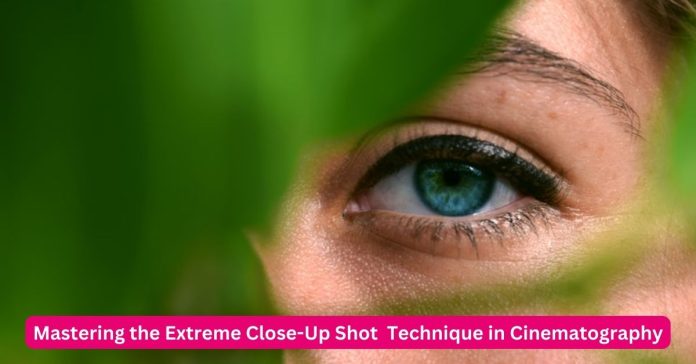In the realm of cinematography, the extreme close-up shot technique holds a significant place, captivating audiences with its intense focus on details. This technique, characterized by its proximity to the subject, offers filmmakers a powerful tool to evoke emotions, intensify narratives, and create immersive visual experiences. In this comprehensive guide, we delve into the nuances of extreme close-up shots, exploring their artistic significance, technical execution, and impact on storytelling.
Extreme Close-Up Shots in Cinematography:
Understanding Extreme Close-Up Shots:
An extreme close-up shot, often abbreviated as ECU or XCU, frames the subject in such a tight composition that only a specific detail or feature is prominently visible on the screen. This technique transcends the conventional boundaries of proximity, allowing filmmakers to magnify even the subtlest expressions, textures, or objects, thereby heightening the visual impact and emotional resonance of the scene.
The Artistic Significance:
The essence of extreme close-up shots lies in their ability to convey intimacy, vulnerability, and authenticity. By isolating minute details or facial expressions, filmmakers can establish a profound connection between the audience and the characters, enabling viewers to empathize with their experiences on a deeper level. Moreover, ECU shots serve as visual metaphors, symbolizing the characters’ inner turmoil, desires, or revelations, thus enriching the narrative with layers of meaning and subtext.
Technical Execution:
Achieving a compelling extreme close-up shot requires meticulous attention to composition, lighting, and camera movement. Cinematographers often employ specialized lenses, such as macro lenses or prime lenses with short focal lengths, to capture fine details with precision. Additionally, careful consideration is given to framing and depth of field, ensuring that the subject remains the focal point while background elements are tastefully blurred to enhance visual clarity and emphasis.
Furthermore, lighting plays a crucial role in accentuating textures, contours, and shadows within the frame, adding depth and dimensionality to the shot. Whether utilizing natural light, artificial sources, or a combination of both, cinematographers leverage various lighting techniques, such as chiaroscuro or rim lighting, to sculpt the subject and evoke the desired mood or atmosphere.
In terms of camera movement, extreme close-up shots are often static or minimally dynamic to maintain focus and clarity. However, subtle tilts, pans, or dolly movements can be employed to infuse dynamism and visual interest while preserving the intimacy and intensity of the composition.
Impact on Storytelling:
Within the cinematic narrative, extreme close-up shots serve as potent storytelling devices, amplifying key moments, emotions, and themes. Whether capturing a tear rolling down a character’s cheek, the quiver of a lip, or the intricate details of an object, ECU shots imbue scenes with visceral immediacy and authenticity, eliciting visceral responses from the audience.
Moreover, these shots facilitate narrative economy by conveying crucial information or subtext without the need for exposition or dialogue. A lingering close-up of a character’s hands nervously fidgeting, for instance, can speak volumes about their inner turmoil or conflicted emotions, allowing viewers to infer meaning through visual cues alone.
Additionally, extreme close-up shots can be used strategically to punctuate dramatic beats, intensify suspense, or underscore thematic motifs throughout the film. By juxtaposing extreme close-ups with wider shots or medium shots, filmmakers can modulate pacing, rhythm, and visual emphasis, thereby shaping the audience’s perception and engagement with the narrative.
Case Studies and Examples:
To illustrate the artistic versatility and narrative impact of extreme close-up shots, let us examine notable examples from cinematic history:
- “Psycho” (1960) – Directed by Alfred Hitchcock: In the iconic shower scene from “Psycho,” Hitchcock employs extreme close-up shots of the protagonist’s face and the slashing knife to heighten tension and visceral horror. The rapid intercutting between extreme close-ups and wider shots intensifies the sense of disorientation and dread, culminating in a cinematic tour de force that remains etched in the annals of film history.
- “The Godfather” (1972) – Directed by Francis Ford Coppola: In a pivotal moment of “The Godfather,” a close-up of Michael Corleone’s eyes as he contemplates his fateful decision to eliminate his enemies captures the internal conflict and moral ambiguity plaguing the character. The extreme close-up serves as a window into Michael’s psyche, revealing the turmoil beneath his composed exterior and foreshadowing his transformation into a reluctant but ruthless leader.
- “Requiem for a Dream” (2000) – Directed by Darren Aronofsky: Darren Aronofsky’s visceral drama “Requiem for a Dream” features haunting extreme close-up shots that vividly depict the physical and emotional degradation of the characters ensnared in the grip of addiction. From the dilated pupils of drug users to the puncture wounds of heroin injections, these intimate glimpses into the characters’ lives evoke a sense of raw, unflinching realism that underscores the film’s harrowing portrayal of addiction’s devastating toll.
Conclusion:
In conclusion, the extreme close-up shot technique stands as a potent tool in the arsenal of filmmakers, offering boundless creative possibilities for visual storytelling. Whether used to evoke empathy, intensify drama, or convey thematic resonance, ECU shots enrich cinematic narratives with depth, nuance, and emotional resonance. By mastering the art of extreme close-up cinematography, filmmakers can elevate their craft and forge indelible connections with audiences, transcending the confines of language and culture to evoke universal truths and experiences on the silver screen.
Related:
- Mastering Close-Up Shot Technique in Cinematography: A Comprehensive Guide
- Unveiling the Artistry of Long Shot in Cinematography: Crafting Timeless Moments on Film




